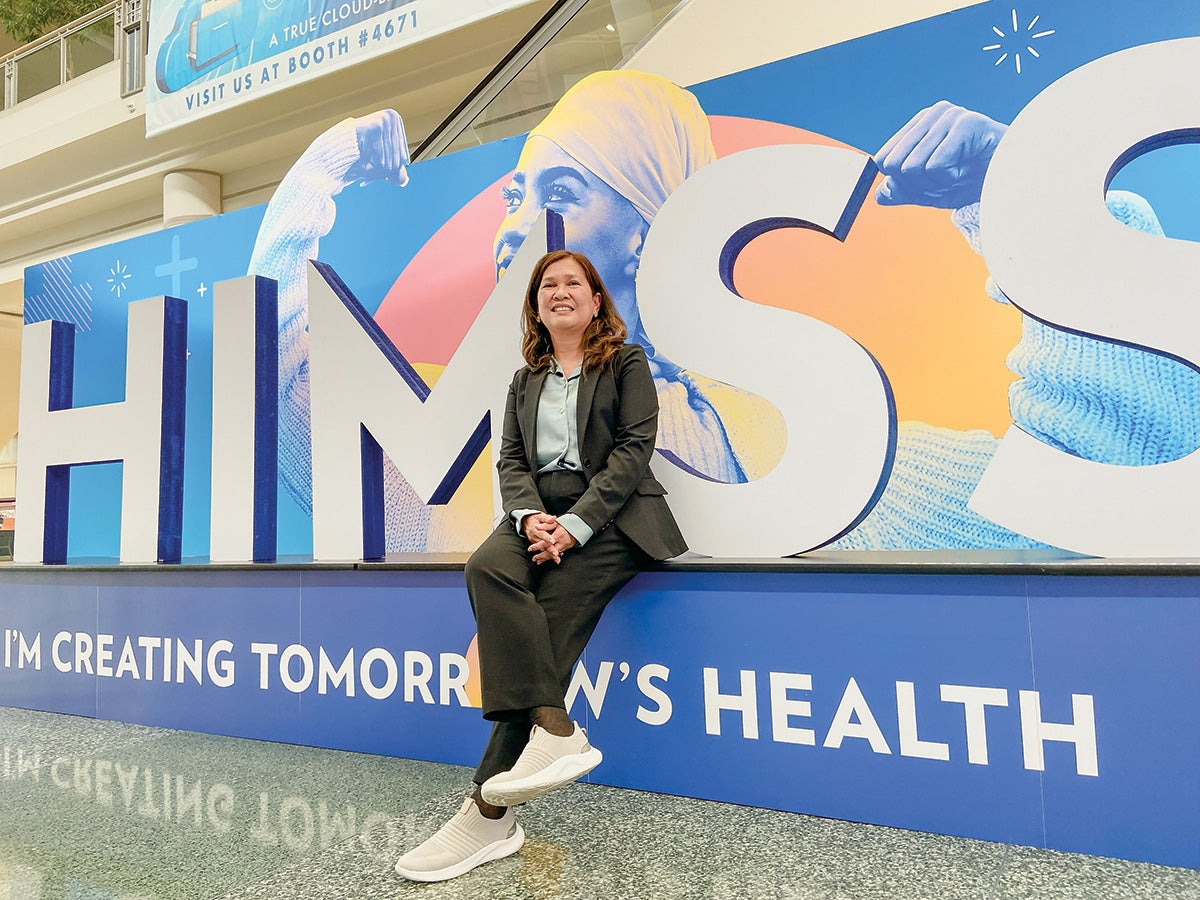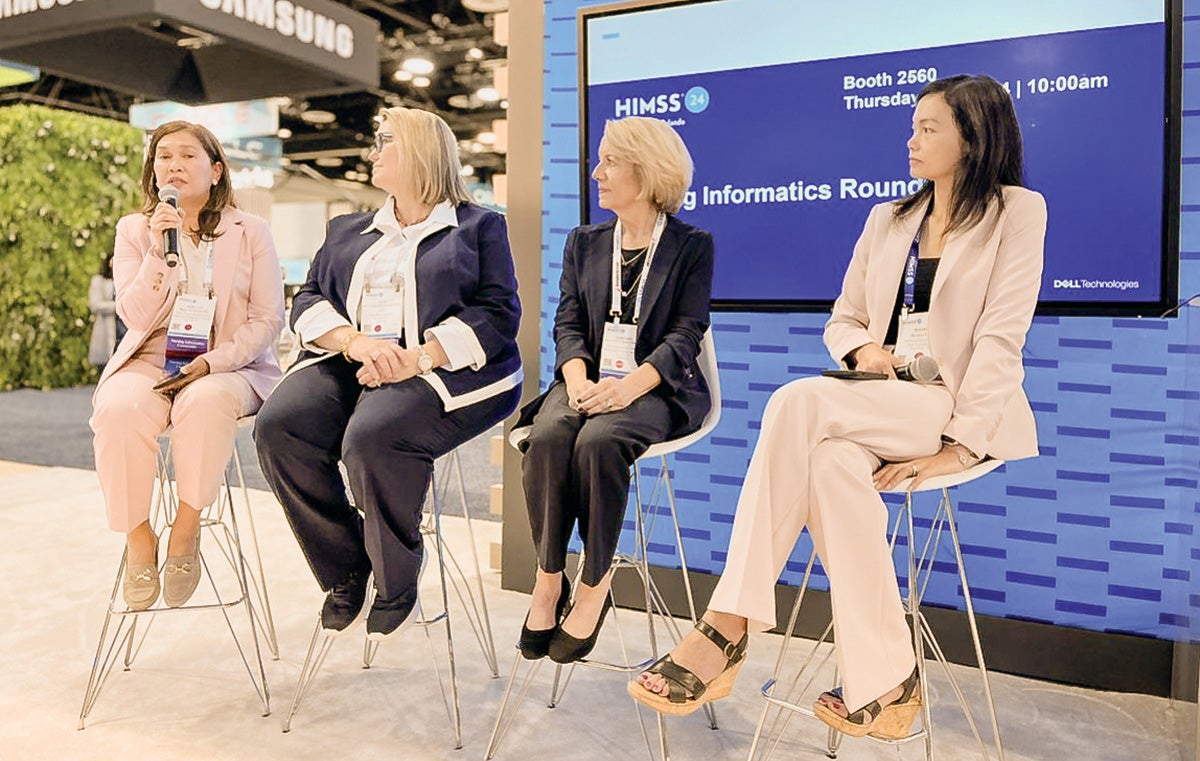connect
Shaping the Future
School of Nursing alumna leads the way as an expert in tech opportunities
 Mary Joy Garcia-Dia at this year's Healthcare Information and Management Systems Society (HIMSS) conference, where she gave a presentation on virtual nursing
Mary Joy Garcia-Dia at this year's Healthcare Information and Management Systems Society (HIMSS) conference, where she gave a presentation on virtual nursingMary Joy Garcia-Dia was so eager to fulfill a childhood dream that she graduated from nursing school in her native Philippines at age 19—two years before she was legally allowed to work as a registered nurse.
"I was super disappointed to learn about that," said GarciaDia, DNP, RN (NUR '15), of the minimum age requirement of 21.
But once she came of nursing age, she was off—to the United States and a career as an expert in the fast-growing field of healthcare technology and a national advocate for nurses.
Now program director of nursing informatics at New York-Presbyterian Hospital in New York City, Garcia-Dia is in the vanguard of a field that integrates nursing with information science and computer science to speed the analysis of patient information, explore treatment options and improve the quality of care.
Technology has become central to patient care and communication, Garcia-Dia said, and nurses are perfectly situated to be the central collectors and disseminators of the information these systems require.
"We are at the bedside 24/7," she said. "We gather data when we talk to our patients, when we interact with our colleagues, when we talk to family members. With the knowledge we have acquired, we hold the glue in ensuring that the right information and the right data is communicated across all the different disciplines."
Garcia-Dia first became intrigued with the ways technology could change nursing practice at a New York hospital that recruited her from the Philippines—and then made her a unit head nurse at age 23.
It was testing a new nursing software application that transferred patients' vital signs from a monitor into an electronic documentation system.
"How does that happen?" she remembers wondering.
Eager to learn more, she volunteered to become a super-user. After earning a master's degree from New York University in nursing informatics, she shifted from critical care to information technology.
 Mary Joy Garcia-Dia, far left, speaking during a panel discussion at the HIMSS conference on the role of nursing informatics in healthcare.
Mary Joy Garcia-Dia, far left, speaking during a panel discussion at the HIMSS conference on the role of nursing informatics in healthcare.SEIZING OPPORTUNITIES
A new path to leadership opened in 2012 when she met Joyce J. Fitzpatrick, PhD, RN, (MGT '92, HON '92), a Distinguished University Professor at Case Western Reserve University's Frances Payne Bolton School of Nursing, during a conference in the Philippines.
Garcia-Dia told Fitzpatrick she wanted to earn a PhD, and felt a new nursing-informatics textbook was needed to incorporate the many advances made since she'd been a student studying the field in 2000.
Fitzpatrick had two suggestions: earn a Doctor of Nursing Practice (DNP) at CWRU's school of nursing to hone her clinical leadership skills—and write her own textbook.
Garcia-Dia followed the advice. For one research project at CWRU, she coauthored a paper with Fitzpatrick (the principal author) that explored the concept of resilience in nursing.
Her dissertation involved text-message vaccination reminders sent to parents in remote areas of the Philippines. She did that research before communication technology with patients was common in healthcare, said Fitzpatrick, who became Garcia-Dia's close colleague and research partner: "She was definitely a pioneer."
Garcia-Dia then followed Fitzpatrick's second suggestion. Her textbook, Project Management in Nursing Informatics, was published in 2019.
In addition, she took on leadership roles at critical junctures, for example, serving as a member of the American Nurses Association's National Commission Addressing Racism in Nursing. She also advocated with partner organizations for the ethical overseas recruitment of nurses with recommendations they made to the Philippine government's Department of Migrant Workers office in Washington, D.C. In 2019, Garcia-Dia was inducted as a fellow into the American Academy of Nursing.
When COVID-19 hit, she created and chaired a task force of the national Philippine Nurses Association of America (PNAA), conducting a survey on the psychosocial impact of the pandemic on Filipino-American nurses, who were on the front lines. Soon after, Garcia-Dia became PNAA's national president, serving from 2020 to 2022. She created, among other initiatives, the "Heal Our Nurses" campaign to raise funds for masks, meals and supportive programs.
During her PNAA presidency, Garcia-Dia also was an inaugural fellow in the Coldiron Senior Nurse Executive Fellowship program, launched through the Marian K. Shaughnessy Nurse Leadership Academy at CWRU.
"She was a key leader within that Coldiron fellowship group," said Fitzpatrick, director of the academy, which was created to enhance and expand the development of senior nurse executive leaders. "Her positive attitude and the relationships she builds are key to her success."
Garcia-Dia credits the academic and leadership-development skills she gained at CWRU with shaping her path.
The experience "helped me create a framework when I became president of the Philippine Nurses Association of America," she said. "In my research paper, I talked about resilience and seeing hope. I think that helped me when I became president."
Garcia-Dia remains at the technological leading edge. A member of the American Academy of Nursing's Technology Expert Panel, she recently joined its new task force examining artificial intelligence and concerns raised by its use in healthcare.
"People will be more comfortable if they understand there is transparency as far as how this is being evaluated, tested, and put to use," she said.
As Garcia-Dia moves on to her latest project—a book telling stories of digital innovations being rolled out in healthcare—she is still working with many faculty members she got to know at CWRU.
"There were so many leaders I met there," she said. "I learned so much. I feel like I'm part of the family."
— BARBARA BROTMAN





